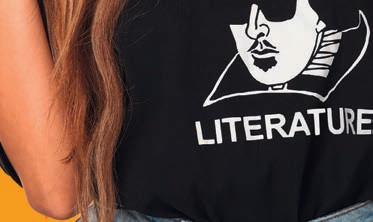























































plus video support








































with Mehr n Baig

Dear Students,
I know you want to get started on your revision, but I just wanted to write you a quick note first.
This guide is based on the AQA English exams, but don’t worry – the skills you learn will be useful for WHATEVER board you are studying!
GCSEs can be a stressful time, and it’s totally normal to feel nervous. But you will be absolutely fine, because I have put EVERYTHING I know into this revision guide and, by the end of it, you will feel SO much more confident. Just trust the process.
I decided to create ‘Glow Up Your Grades’ because I truly believe that every child deserves the chance to do well in their education and to build a good future for themselves. The time and effort you put in now will, one day, give you the chance to create a better life for yourself and those around you.
You’ve already done the hardest part! You have bought this revision guide and are reading the first page. I am SO proud of you. Now leave the rest to me! Work through this guide slowly and, together, we will conquer all your fears. There are links to some of my videos for some extra practice too – so by the time you walk into that exam hall, you’ll basically be Shakespeare.



I am so excited for you. Work hard and make yourself proud. You’ve got this.
Search
‘Glow Up Your Grades’ online to find more of my videos to help with your revision.











Now, as we know, the Language paper is quite amazing because we already know what questions are going to come up. It’s only the extract that changes. So, Question 3 will always be:
You now need to think about the whole of the source. This text is taken from the beginning of a novel.
How has the writer structured the text to interest you as a reader?
You could write about:
•what the writer focuses your attention on at the beginning of the source
•how and why the writer changes this focus as the source develops
•any other structural features that interest you. [8 marks]
It’s the structure question! So, in the same way that you had to prove that you can identify a language device – like a simile or a metaphor – and analyse the effect in Question 2, you have to prove that you can identify STRUCTURAL techniques and analyse their effect for Question 3.
Everyone always hates Question 3 because they don’t know what structural techniques they should be looking for. So let me tell you.

It’s

•Long or short paragraphs
•A section of dialogue (speech)
that example,
• Foreshadowing (when there is a hint that something will happen later in the extract)
• A change in setting (for example, if the beginning of the extract describes INSIDE a building and then in the middle it describes OUTSIDE the building)
• A shift in tone (like if the beginning of the extract is happy and then it becomes sad)
•An introduction to a main/new character
•A ashback
•A cliffhanger

• A cyclical structure (when the beginning of the extract is similar to the end of the extract)




I mean, technically, I don’t even need to read the extract to attempt this question. I can literally look at the extract and start getting ideas about what I’m going to talk about just from what it looks like on the page. I can see where there’s an extra-long or extra-short paragraph, or where there’s a section of dialogue. And then when I look deeper and start re-reading, I can nd even more things from my structural devices list.
Short, oneor two-line paragraphs
Starts with dialogue Cyclical structure
‘I’m not old,’ she whispered under her breath.
With one frail finger, the woman traced the outline of her reflection. There were deep, dark, dreadful lines engraved into her skin. Her nails were cracked, half bitten, half marked by the burden of age. With slight trepidation, she lifted her heavy eyelids to look further up her arm. Her brownish skin seemed paler than usual; green veins protruded like caterpillars crawling under her skin.
Conscious of her trembling hands, the old woman reached towards the glass trophy that sat balanced on her mantelpiece. The coldness of its exterior startled her. She clenched onto it tightly, unable to bear the thought of it slipping from her sweaty palms. Unable to let the past go.
Beneath a layer of grey dust, the old woman could see her face trapped… imprisoned within the shiny surface. The wrinkles around her eyes distorted their original beauty and form. Her lips were chapped, pursed, and her cheeks sunken in. Her flat, greasy hair hung like colourless strings. She drew in her breath sharply, asking the mirror silent questions.
Looking at her current state, it was almost impossible to imagine the beauty she once possessed.
Once, she was Venus. Draped in a dress that was a deep azure in colour, it was as though midnight itself had swept around her. Twinkling stars shone out of the swathes of material, and the glitter cascaded behind her as she glided across the stage, like a divine light. Her feet were blessed with clementine shoes and her body adorned with enchanting jewels. Falling in waves down her slender back, her long, blonde hair undulated to the rhythm of her movement; loose strands protected her porcelain face, guarding its perfection with fierce peacock pride. Her eyes sparkled like diamonds, and were so blue that even poetry would have failed to capture their essence and depth; her eyes told a story and spoke to millions without uttering a single syllable. She smiled radiantly at her admirers. Her eyes opened wide as she reached the centre of the stage, and she swung her hair back to get a full view of her award.
The glass trophy.
With a steady hand and stable fingers, she reached towards the prized possession. She displayed it with confidence and a natural ease. Cameras flashed incessantly, blinding her.
‘I’m not old!’ the old woman shrieked aloud. The noise shook her frail fingers and the trophy slipped from her weak grip. As it hovered between the air and the ground, she closed her eyes and waited to hear the traumatising sound of smashing glass.
‘I’m not old.’
Introduces main character
Longest paragraph/ flashback
Question 4 is a big one. It’s a 20 marker (HALF OF THE WHOLE READING SECTION!) and it looks something like this:
Focus this part of your answer on the second half of the source, from line 19 to the end.
A student said, ‘This part of the story shows the old woman is struggling to cope with how different her life is now that she is older and makes readers empathise with Venus.’
To what extent do you agree?
In your response, you could:
•consider your own impressions of Venus •evaluate how the writer makes you empathise with her •support your response with references to the text. [20 marks]
So, the examiners basically give you a statement that they think is true, and they want you to write around THREE to FOUR paragraphs nding evidence that backs it up. If you want to, you could write two ‘agree’ paragraphs and one ‘disagree’. But I would always make sure you are agreeing more than disagreeing. It helps thinking about the Language paper as a whole – every question you’ve done so far has built up to this moment. In Question 1, they made you practise selecting quotations. In Question 2, they gave you a mini warm-up of looking for language devices and analysing them. Question 3 was about structure. And now, you’re going to put it all together into one analytical essay.
Let’s remind ourselves about the extract, line 19 to the end. As always, in the real exam, I would draw a box around those lines in a different coloured pen to make sure I don’t accidentally write about the wrong lines.
Looking at her current state, it was almost impossible to imagine the beauty she once possessed.
Once, she was Venus. Draped in a dress that was a deep azure in colour, it was as though midnight itself had swept around her. Twinkling stars shone out of the swathes of material, and the glitter cascaded behind her as she glided across the stage, like a divine light. Her feet were blessed with clementine shoes and her body adorned with enchanting jewels. Falling in waves down her slender back, her long, blonde hair undulated to the rhythm of her movement; loose strands protected her porcelain face, guarding its perfection with fierce peacock pride. Her eyes sparkled like diamonds, and were so blue that even poetry would have failed to capture their essence and depth; her eyes told a story and spoke to millions without uttering a single syllable. She smiled radiantly at her admirers. Her eyes opened wide as she reached the centre of the stage, and she swung her hair back to get a full view of her award. The glass trophy.
With a steady hand and stable fingers, she reached towards the prized possession. She displayed it with confidence and a natural ease. Cameras flashed incessantly, blinding her.
‘I’m not old!’ the old woman shrieked aloud. The noise shook her frail fingers and the trophy slipped from her weak grip. As it hovered between the air and the ground, she closed her eyes and waited to hear the traumatising sound of smashing glass. ‘I’m not old.’
Because this question is worth SO many marks, these paragraphs are going to be WAY LONGER than any of the ones you wrote for Question 2 and Question 3.
Do you think Venus is struggling to cope? Do you feel sorry for her? Yes, I think so too. But how does the writer show this?
Let’s pick our THREE JUICIEST quotations – that means quotations with interesting language or structural devices –to prove that she is struggling to cope and we empathise with her.

‘The noise shook er ra l fin ers and the trophy slipped from her weak grip.’
I’m really excited to write about this one! I will analyse how the trophy is actually a microcosm of Venus’s youth, and the fact that it’s ‘slipping’ away from her shows how she is being forced to let go of her past self, even though she doesn’t want to. I can mention the fricative alliteration too and link that to being a sad sound.


‘“I’m not old!” the old woman shrieked aloud.’
I see an exclamation mark in her dialogue – so you know I’m going to talk about it. I can say that ‘shrieked’ is onomatopoeic. But also, it’s ironic that she’s screaming that she’s ‘“not old!”’, yet in the very same sentence, the narrative voice describes her as ‘the old woman’.


‘Her eyes sparkled like diamonds, and were so blue…’
Here, I’m going to talk about the simile of ‘diamonds’, and how valued she felt when she was younger. And then I can go in on the colour imagery of ‘blue’ (OBVS), exploring the connotations of the sky and sea. I’ll link that to how Venus felt free when she was younger. I might bring in the fact that this is the longest paragraph too, so that I’ve analysed some structure.

Now that I’ve got my plan, I can start writing my paragraphs out.








In a description, it isn’t necessary to include dialogue – but when you’re writing a STORY, you should include someone speaking. You don’t want to include LOADS of dialogue between characters. This is not a play. This is an exam and you want to get maximum marks by spending more time on your DESCRIPTIVE BITS. The maximum I will allow you is TWO LINES of dialogue if you absolutely HAVE to… but please don’t get carried away.
I quite like to have a character talk to themselves. Like:
‘This is incredible,’ he whispered under his breath.
Now, what we don’t want is for you to end up LOSING marks because you didn’t punctuate your dialogue correctly.
So, the rules are:
• You need a capital letter to start the dialogue.
• The bit after the dialogue where you say ‘he said’ does NOT need a capital letter.
• All punctuation goes INSIDE the speech marks.
• When a new character speaks, it goes on a NEW LINE.

You don’t want to include LOADS of dialogue between characters. This is not a play.



















It would be really boring if every sentence you wrote started with THE THE THE THE. And it would also be really boring if all of your sentences were the same length. You need to include a mixture of long, descriptive sentences, and then mix that up with some short, dramatic sentences. You also need to make sure you are starting your sentences in different ways.
A simple sentence is the same as a MAIN CLAUSE:
The stars were glistening.
Lovely. Simple. No comma. Makes sense by itself.
A complex sentence is made up of a main clause and a subordinate clause. A subordinate clause is a bit of extra information that doesn’t make sense by itself. It needs a comma. Like this:
In the sky,the stars were glistening.
There are different types of subordinate clauses you can start your sentences with. Let me give you some options:
•Start with WHERE something is (a PREPOSITION):
In the obsidian sky,the stars were glistening.
•Start with WHEN something happened:
After the sun had set,the stars were glistening.
•Start with an ADVERB (-ly):
Radiantly,the stars were glistening.
•Start with a VERB (-ing):
Watching the world below,the stars were glistening.
Try to include a oneword sentence in there somewhere.
Subordinate clauses don’t just go at the start of your sentences, they can go at the end too: The stars were glistening,watching the world below.
When you get good at this, subordinate clauses can split the main clause apart and go in the middle, with what I like to call a comma sandwich: The stars,watching the world below,were glistening.
And when you become super clever, you can put the subordinate clause at the beginning AND the end of the sentence, to create extra-long sentences: Radiantly,the stars were glistening,watching the world below.
Let’s highlight the main and subordinate clauses in the section we just wrote, to make sure we have a mixture of both in different places:
Nature had awoken from its wintry slumber. I stood still,absorbing every pixel of the perfect painting. Gently,dewdrops floated in the cool air,before eventually decorating the ground like fragments of diamonds on the finest Indian silk. Under the melody of the gentle breeze,robins whistled and sang happy jingles,ready for the promise of a new season.God was conducting the perfect orchestra.
We want to avoid starting speeches like, ‘HELLO, MY NAME IS MEHREEN AND TODAY I WILL TALK TO YOU ABOUT BANNING MOBILE PHONES.’ Because that is sooo boring. Imagine if Martin Luther King did that. He wouldn’t.
So, we want your opening to be as imaginative, and shocking, and unique as possible. You want to stand out from all the ‘HELLO, MY NAME IS MEHREEN’ students.
1 Start with three one-word sentences as a one-line paragraph (like I suggested in Paper 1 – do you remember?). Something like: Knowledge. Protection. Power.
It’s dramatic. It’s interesting. It’s different. It will capture the attention of the examiner
2 Start with a shocking statistic:
By the time I finish reading this speech, 2.6 million calls will be made to the emergency services.
3 Start with a rhetorical question:
Have you ever wondered what it’s like to be stuck in a dangerous situation, with no way of contacting someone for help?
4 And lastly, my favourite. Start with an ‘Imagine this:’. This gives you the chance to be really creative and descriptive, before getting into the actual persuasive speech. Something like this:
Imagine this: You’re walking down an isolated alleyway on a wintry night. You are engulfed in deep darkness. You are alone. Except… are you? You hear footsteps behind you, approaching softly and slowly at first, before speeding up. Frantically, you reach into your pocket to contact someone for help – for someone to save you. But your pocket is empty. Why?
Because mobile phones have been banned for teenagers.
After that, you explain who you are and what your stance is clearly, just as you did in your letter. And then you insert your three body paragraphs.
Now obviously, we can’t end a speech, ‘Yours faithfully,’… so you can just end it with the ‘I hope you do the right thing’ conclusion paragraph. BUT, if you’re aiming for the highest level, why not see if you can make your speech cyclical, by referring back to your opening?
Something like this:
We must ensure no child is ever left exposed in an isolated alleyway with no way to call for help. We must ensure no child ever feels alone. We must not ban mobile phones.
For more on this, see my video:

So… we now know
•Write a persuasive letter, AND •A persuasive speech.
It’s basically the same thing, except YOU NEED A HEADLINE. Try to make this catchy, so use alliteration or a pun – for example:
•Ban-droid!
•No More Cell- es!
•Cell Out!
•No-bile Phones for Teenagers!
I had way too much fun thinking of those! Anyway, if you can’t think of a pun on the day, it really doesn’t matter. Alliteration or even a rhetorical question will do the job. For example:
•Cutting the Cord!
•Should Monstrous Mobiles Be Banned?
And then the rest of the article is similar to the structure of the speech –just slightly less chatty and conversational.
Right… you have all the knowledge you need. Why don’t you pick a topic from the list below and try writing a letter about it, then turn it into a speech, and then an article. You will feel SO much better once you’ve given it a go yourself.
• ‘Online learning is more effective than traditional classroom learning.’

•‘The voting age should be lowered to 16.’
•‘There should be no more school uniforms.’
•‘Footballers should be paid more than teachers.’ (Umm… NO.)
And that’s all folks!
English Language has come to an end.




Now go and have a well-deserved rest… until we meet again for Literature xx


Make sure you start each word of the headline with CAPITAL LETTERS.






